一起读源码之zookeeper(1) -- 启动分析
从本文开始,不定期分析一个开源项目源代码,起篇从大名鼎鼎的zookeeper开始。
为什么是zk,因为用到zk的场景实在太多了,大部分耳熟能详的分布式系统都有zookeeper的影子,比如hbase,storm,dubbo,kafka等等,另外前面提到的RPC框架原理与实现也用到了zookeeper。
1 环境准备#
首先,下载zk的新版本,最新的稳定版是3.4.10,由于已下载3.4.9.先直接使用。
1.1 导入代码#
项目设置为jdk1.7
然后,将src/java下面的main和generated设置为源码目录,同时将lib目录添加为liabary。
1.2 设置配置文件#
在conf目录,新建zoo.cfg,拷贝sample.cfg即可
1.3 调试配置#
查看bin/zkServer
set ZOOMAIN=org.apache.zookeeper.server.quorum.QuorumPeerMain
....
endlocal
调用的是org.apache.zookeeper.server.quorum.QuorumPeerMain,因此QuorumPeerMain,配置调试程序,arguments设置conf/zoo.cfg
这样,就可以愉快的Debug代码了-😃
2 启动分析#
2.1 QuorumPeerMain#
QuorumPeerMain的main里,调用initializeAndRun
protected void initializeAndRun(String[] args)
throws ConfigException, IOException
{
QuorumPeerConfig config = new QuorumPeerConfig();
if (args.length == 1) {
config.parse(args[0]);
}
// Start and schedule the the purge task 清理任务
DatadirCleanupManager purgeMgr = new DatadirCleanupManager(config
.getDataDir(), config.getDataLogDir(), config
.getSnapRetainCount(), config.getPurgeInterval());
purgeMgr.start();
// 集群模式
if (args.length == 1 && config.servers.size() > 0) {
runFromConfig(config);
} else {
LOG.warn("Either no config or no quorum defined in config, running "
+ " in standalone mode");
// there is only server in the quorum -- run as standalone
// 单机模式
ZooKeeperServerMain.main(args);
}
}
主要执行了:
- 加载解析配置文件到QuorumPeerConfig
- 执行清理任务
- 判断是集群模式还是单机模式,我们的配置文件未配置server,所以是单机模式,执行 ZooKeeperServerMain.main
本文重点分析单机模式下的zk,集群模式暂时不解读
2.2 ZooKeeperServerMain#
ZooKeeperServerMain.main调用initializeAndRun
protected void initializeAndRun(String[] args)
throws ConfigException, IOException
{
try {
ManagedUtil.registerLog4jMBeans();
} catch (JMException e) {
LOG.warn("Unable to register log4j JMX control", e);
}
ServerConfig config = new ServerConfig();
if (args.length == 1) {
config.parse(args[0]);
} else {
config.parse(args);
}
runFromConfig(config);
}```
读取配置,然后runFromConfig:
``` java
public void runFromConfig(ServerConfig config) throws IOException {
LOG.info("Starting server");
FileTxnSnapLog txnLog = null;
try {
// Note that this thread isn't going to be doing anything else,
// so rather than spawning another thread, we will just call
// run() in this thread.
// create a file logger url from the command line args
final ZooKeeperServer zkServer = new ZooKeeperServer();
// Registers shutdown handler which will be used to know the
// server error or shutdown state changes.
final CountDownLatch shutdownLatch = new CountDownLatch(1);
zkServer.registerServerShutdownHandler(
new ZooKeeperServerShutdownHandler(shutdownLatch));
// 快照
txnLog = new FileTxnSnapLog(new File(config.dataLogDir), new File(
config.dataDir));
zkServer.setTxnLogFactory(txnLog);
zkServer.setTickTime(config.tickTime);
zkServer.setMinSessionTimeout(config.minSessionTimeout);
zkServer.setMaxSessionTimeout(config.maxSessionTimeout);
// socket工厂
cnxnFactory = ServerCnxnFactory.createFactory();
cnxnFactory.configure(config.getClientPortAddress(),
config.getMaxClientCnxns());
cnxnFactory.startup(zkServer);
// Watch status of ZooKeeper server. It will do a graceful shutdown
// if the server is not running or hits an internal error.
shutdownLatch.await();
shutdown();
cnxnFactory.join();
if (zkServer.canShutdown()) {
zkServer.shutdown();
}
} catch (InterruptedException e) {
// warn, but generally this is ok
LOG.warn("Server interrupted", e);
} finally {
if (txnLog != null) {
txnLog.close();
}
}
}
几件事情:
- 创建zkServer,对ZooKeeperServer设置一些配置参数,如tickTime、minSessionTimeout、maxSessionTimeout
- 创建CountDownLatch,注释里写了,用来watch zk的状态,当zk关闭或者出现内部错误的时候优雅的关闭服务
- 根据配置参数dataLogDir和dataDir创建FileTxnSnapLog,用来存储zk数据和日志快照
- 创建cnxnFactory,zk的 socket工厂,负责处理网络请求,zk里有netty和NIO两种实现
- cnxnFactory.startup(zkServer),启动zk服务器
2.3 ServerCnxnFactory#
cnxnFactory负责zk的网络请求,createFactory中,从系统配置中读取ZOOKEEPER_SERVER_CNXN_FACTORY,默认是没有这个配置的,因此默认是使用NIOServerCnxnFactory,基于java的NIO实现,
static public ServerCnxnFactory createFactory() throws IOException {
String serverCnxnFactoryName =
System.getProperty(ZOOKEEPER_SERVER_CNXN_FACTORY);
if (serverCnxnFactoryName == null) {
serverCnxnFactoryName = NIOServerCnxnFactory.class.getName();
}
try {
return (ServerCnxnFactory) Class.forName(serverCnxnFactoryName)
.newInstance();
} catch (Exception e) {
IOException ioe = new IOException("Couldn't instantiate "
+ serverCnxnFactoryName);
ioe.initCause(e);
throw ioe;
}
}
ServerCnxnFactory还有个NettyServerCnxnFactory实现,基于Netty实现NIO。ServerCnxnFactory里具体负责什么,后面再来看。
2.4 ZooKeeperServer#
现在,主角登场,我们来看ZooKeeperServer内部有什么玄妙。
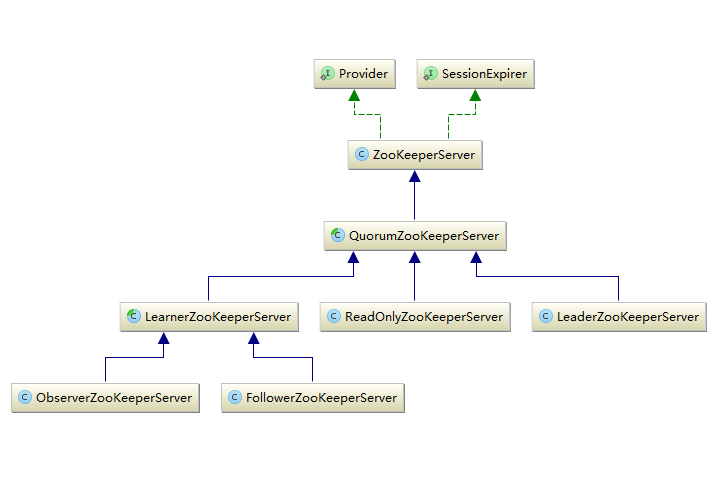
ZooKeeperServer是单机模式使用的类,在集群模式下使用的是它的子类。
我们先来看ZooKeeperServer包含哪些内容:
public static final int DEFAULT_TICK_TIME = 3000;
protected int tickTime = DEFAULT_TICK_TIME;
/** value of -1 indicates unset, use default */
protected int minSessionTimeout = -1;
/** value of -1 indicates unset, use default */
protected int maxSessionTimeout = -1;
protected SessionTracker sessionTracker; //创建和管理session
private FileTxnSnapLog txnLogFactory = null; //文件快照
private ZKDatabase zkDb; // ZooKeeper树形数据的模型
private final AtomicLong hzxid = new AtomicLong(0); //原子增长Long,用于分配事务编号
public final static Exception ok = new Exception("No prob");
protected RequestProcessor firstProcessor; // ZooKeeperServer请求处理器链中的第一个处理器
protected volatile State state = State.INITIAL;
protected enum State {
INITIAL, RUNNING, SHUTDOWN, ERROR;
}
/**
* This is the secret that we use to generate passwords, for the moment it
* is more of a sanity check.
*/
static final private long superSecret = 0XB3415C00L;
private final AtomicInteger requestsInProcess = new AtomicInteger(0);
final List<ChangeRecord> outstandingChanges = new ArrayList<ChangeRecord>();
// this data structure must be accessed under the outstandingChanges lock
final HashMap<String, ChangeRecord> outstandingChangesForPath =
new HashMap<String, ChangeRecord>();
private ServerCnxnFactory serverCnxnFactory; //ServerSocket工厂,接受客户端的socket连接
private final ServerStats serverStats; //server的运行状态统计
private final ZooKeeperServerListener listener; // ZK运行状态监听
private ZooKeeperServerShutdownHandler zkShutdownHandler;
2.5 服务启动#
前面有点跑偏,继续回归启动过程:
cnxnFactory = ServerCnxnFactory.createFactory();
cnxnFactory.configure(config.getClientPortAddress(),
config.getMaxClientCnxns());
cnxnFactory.startup(zkServer);
2.5.1 配置cnxnFactory#
进入configure:
@Override
public void configure(InetSocketAddress addr, int maxcc) throws IOException {
configureSaslLogin();
// ZK网络请求主线程
thread = new ZooKeeperThread(this, "NIOServerCxn.Factory:" + addr);
thread.setDaemon(true);
maxClientCnxns = maxcc;
this.ss = ServerSocketChannel.open();
ss.socket().setReuseAddress(true);
LOG.info("binding to port " + addr);
ss.socket().bind(addr);
ss.configureBlocking(false);
ss.register(selector, SelectionKey.OP_ACCEPT);
}
几件事情:
- configureSaslLogin,具体不细看,应该是处理鉴权
- 初始化ZooKeeperThread,这个ZooKeeperThread的作用是负责处理未处理异常:
public class ZooKeeperThread extends Thread {
private static final Logger LOG = LoggerFactory
.getLogger(ZooKeeperThread.class);
private UncaughtExceptionHandler uncaughtExceptionalHandler = new UncaughtExceptionHandler() {
@Override
public void uncaughtException(Thread t, Throwable e) {
handleException(t.getName(), e);
}
};
public ZooKeeperThread(Runnable thread, String threadName) {
super(thread, threadName);
setUncaughtExceptionHandler(uncaughtExceptionalHandler);
}
protected void handleException(String thName, Throwable e) {
LOG.warn("Exception occured from thread {}", thName, e);
}
}
- 启动ServerSocketChannel,并绑定配置的addr,并且注册selector(可以搜索NIO了解细节)
2.5.2 启动cnxnFactory#
继续分析,进入cnxnFactory.startup(zkServer)
@Override
public void startup(ZooKeeperServer zks) throws IOException,
InterruptedException {
start();
setZooKeeperServer(zks);
zks.startdata();
zks.startup();
}
首先,start,判断线程状态,如果未启动则启动线程,注意只会启动一次。
@Override
public void start() {
// ensure thread is started once and only once
if (thread.getState() == Thread.State.NEW) {
thread.start();
}
}
socket处理线程
启动后,就会执行cnxnFactory.run
public void run() {
while (!ss.socket().isClosed()) {
try {
selector.select(1000);
Set<SelectionKey> selected;
synchronized (this) {
selected = selector.selectedKeys();
}
ArrayList<SelectionKey> selectedList = new ArrayList<SelectionKey>(
selected);
Collections.shuffle(selectedList);
for (SelectionKey k : selectedList) {
if ((k.readyOps() & SelectionKey.OP_ACCEPT) != 0) {
SocketChannel sc = ((ServerSocketChannel) k
.channel()).accept();
InetAddress ia = sc.socket().getInetAddress();
int cnxncount = getClientCnxnCount(ia);
if (maxClientCnxns > 0 && cnxncount >= maxClientCnxns){
LOG.warn("Too many connections from " + ia
+ " - max is " + maxClientCnxns );
sc.close();
} else {
LOG.info("Accepted socket connection from "
+ sc.socket().getRemoteSocketAddress());
sc.configureBlocking(false);
SelectionKey sk = sc.register(selector,
SelectionKey.OP_READ);
NIOServerCnxn cnxn = createConnection(sc, sk);
sk.attach(cnxn);
addCnxn(cnxn);
}
} else if ((k.readyOps() & (SelectionKey.OP_READ | SelectionKey.OP_WRITE)) != 0) {
NIOServerCnxn c = (NIOServerCnxn) k.attachment();
c.doIO(k);
} else {
if (LOG.isDebugEnabled()) {
LOG.debug("Unexpected ops in select "
+ k.readyOps());
}
}
}
selected.clear();
} catch (RuntimeException e) {
LOG.warn("Ignoring unexpected runtime exception", e);
} catch (Exception e) {
LOG.warn("Ignoring exception", e);
}
}
closeAll();
LOG.info("NIOServerCnxn factory exited run method");
}
这里相当于一个独立线程来处理网络连接,通过selector.select(1000)来获取网络请求,一旦有连接就绪,则开始处理:
- 首先打乱 Collections.shuffle(selectedList);
- for循环处理
- 如果SelectionKey.OP_ACCEPT,代表一个新连接请求,创建SocketChannel,创建NIOServerCnxn,然后addCnxn
- 如果可读写,则 NIOServerCnxn.doIO(k),执行IO操作
socket网络请求处理
这里简单分析下doIO,摘录部分代码:
void doIO(SelectionKey k) throws InterruptedException {
try {
if (isSocketOpen() == false) {
LOG.warn("trying to do i/o on a null socket for session:0x"
+ Long.toHexString(sessionId));
return;
}
if (k.isReadable()) {
// 读取4个字节
int rc = sock.read(incomingBuffer);
if (rc < 0) {
throw new EndOfStreamException(
"Unable to read additional data from client sessionid 0x"
+ Long.toHexString(sessionId)
+ ", likely client has closed socket");
}
// 读满了
if (incomingBuffer.remaining() == 0) {
boolean isPayload;
if (incomingBuffer == lenBuffer) { // start of next request
incomingBuffer.flip(); // 复位
isPayload = readLength(k); // 读取载荷长度
incomingBuffer.clear();
} else {
// continuation
isPayload = true;
}
if (isPayload) { // not the case for 4letterword
readPayload();
}
else {
// four letter words take care
// need not do anything else
return;
}
}
}
读取4个字节,获取到数据长度,然后读取载荷,也就是请求
private void readPayload() throws IOException, InterruptedException {
if (incomingBuffer.remaining() != 0) { // have we read length bytes?
int rc = sock.read(incomingBuffer); // sock is non-blocking, so ok
if (rc < 0) {
throw new EndOfStreamException(
"Unable to read additional data from client sessionid 0x"
+ Long.toHexString(sessionId)
+ ", likely client has closed socket");
}
}
if (incomingBuffer.remaining() == 0) { // have we read length bytes?
packetReceived();
incomingBuffer.flip(); // 复位
if (!initialized) {
readConnectRequest(); // 读取连接请求
} else {
readRequest();
}
lenBuffer.clear();
incomingBuffer = lenBuffer;
}
}
先是读取数据,然后再读取请求,这里关注readConnectRequest
读取连接请求
private void readConnectRequest() throws IOException, InterruptedException {
if (zkServer == null) {
throw new IOException("ZooKeeperServer not running");
}
zkServer.processConnectRequest(this, incomingBuffer);
initialized = true;
}
继续,下面是处理连接请求:
public void processConnectRequest(ServerCnxn cnxn, ByteBuffer incomingBuffer) throws IOException {
BinaryInputArchive bia = BinaryInputArchive.getArchive(new ByteBufferInputStream(incomingBuffer));
ConnectRequest connReq = new ConnectRequest();
connReq.deserialize(bia, "connect"); // 反序列化请求
....
// 客户端设置的超时时间
int sessionTimeout = connReq.getTimeOut();
byte passwd[] = connReq.getPasswd();
int minSessionTimeout = getMinSessionTimeout();
if (sessionTimeout < minSessionTimeout) {
sessionTimeout = minSessionTimeout;
}
// 服务端设置的最大超时时间
int maxSessionTimeout = getMaxSessionTimeout();
if (sessionTimeout > maxSessionTimeout) {
sessionTimeout = maxSessionTimeout;
}
cnxn.setSessionTimeout(sessionTimeout);
// We don't want to receive any packets until we are sure that the
// session is setup
cnxn.disableRecv();
// 请求是否带上sessionid
long sessionId = connReq.getSessionId();
if (sessionId != 0) {
// 请求带了sessionid
long clientSessionId = connReq.getSessionId();
LOG.info("Client attempting to renew session 0x"
+ Long.toHexString(clientSessionId)
+ " at " + cnxn.getRemoteSocketAddress());
// 关闭请求
serverCnxnFactory.closeSession(sessionId);
cnxn.setSessionId(sessionId);
// 重新打开请求
reopenSession(cnxn, sessionId, passwd, sessionTimeout);
} else {
LOG.info("Client attempting to establish new session at "
+ cnxn.getRemoteSocketAddress());
// 创建新sesssion
createSession(cnxn, passwd, sessionTimeout);
}
}
以上完成:
- 将读取出来的incomingBuffer反序列化为ConnectRequest对象
- 然后设置超时时间,ServerCnxn接收到该申请后,根据客户端传递过来的sessionTimeout时间以及ZooKeeperServer本身的minSessionTimeout、maxSessionTimeout参数,确定最终的sessionTimeout时间
- 判断客户端的请求是否已经含有sessionId
- 如果含有,则执行sessionId的是否过期、密码是否正确等检查
- 如果没有sessionId,则创建一个session
创建session
所以,我们需要再看一下如何创建session:
long createSession(ServerCnxn cnxn, byte passwd[], int timeout) {
long sessionId = sessionTracker.createSession(timeout);
Random r = new Random(sessionId ^ superSecret);
r.nextBytes(passwd);
ByteBuffer to = ByteBuffer.allocate(4);
to.putInt(timeout);
cnxn.setSessionId(sessionId);
submitRequest(cnxn, sessionId, OpCode.createSession, 0, to, null);
return sessionId;
}
- 使用sessionTracker生成一个sessionId
- submitRequest构建一个Request请求,请求的类型为OpCode.createSession
private void submitRequest(ServerCnxn cnxn, long sessionId, int type,
int xid, ByteBuffer bb, List<Id> authInfo) {
Request si = new Request(cnxn, sessionId, xid, type, bb, authInfo);
submitRequest(si);
}
public void submitRequest(Request si) {
if (firstProcessor == null) {
synchronized (this) {
try {
// Since all requests are passed to the request
// processor it should wait for setting up the request
// processor chain. The state will be updated to RUNNING
// after the setup.
while (state == State.INITIAL) {
wait(1000);
}
} catch (InterruptedException e) {
LOG.warn("Unexpected interruption", e);
}
if (firstProcessor == null || state != State.RUNNING) {
throw new RuntimeException("Not started");
}
}
}
try {
touch(si.cnxn);
boolean validpacket = Request.isValid(si.type);
if (validpacket) {
firstProcessor.processRequest(si);
if (si.cnxn != null) {
incInProcess();
}
} else {
LOG.warn("Received packet at server of unknown type " + si.type);
new UnimplementedRequestProcessor().processRequest(si);
}
} catch (MissingSessionException e) {
if (LOG.isDebugEnabled()) {
LOG.debug("Dropping request: " + e.getMessage());
}
} catch (RequestProcessorException e) {
LOG.error("Unable to process request:" + e.getMessage(), e);
}
}
上面的代码:
- 创建一个Request
- 等待firstProcessor创建完成,然后调用firstProcessor.processRequest
firstProcessor是什么东东,下面再揭晓
2.5.3 zk服务器启动#
再次回到startup, setZooKeeperServer(zks),代码很简单
final public void setZooKeeperServer(ZooKeeperServer zk) {
this.zkServer = zk;
if (zk != null) {
zk.setServerCnxnFactory(this);
}
}
然后是zk服务器的startdata:
public void startdata()
throws IOException, InterruptedException {
//check to see if zkDb is not null
if (zkDb == null) {
zkDb = new ZKDatabase(this.txnLogFactory);
}
if (!zkDb.isInitialized()) {
loadData();
}
}
初始化ZKDatabase,从txnLogFactory里读取快照数据。
最后是zk服务器的startup:
public synchronized void startup() {
if (sessionTracker == null) {
createSessionTracker();
}
startSessionTracker();
setupRequestProcessors();
registerJMX();
setState(State.RUNNING);
notifyAll();
}
几件事情:
- createSessionTracker创建sessionTracker
- startSessionTracker启动SessionTracker
- setupRequestProcessors 创建请求处理器链
- registerJMX 注册JMX
- setState(State.RUNNING) 设置状态为运行中
SessionTracker
看SessionTracker的注释:
This is the basic interface that ZooKeeperServer uses to track sessions.
负责追踪Session的
在zk里的实现是SessionTrackerImpl:
protected void createSessionTracker() {
sessionTracker = new SessionTrackerImpl(this, zkDb.getSessionWithTimeOuts(),
tickTime, 1, getZooKeeperServerListener());
}
protected void startSessionTracker() {
((SessionTrackerImpl)sessionTracker).start();
}
SessionTrackerImpl后面再详细分析。
2.5.4 ZooKeeperServer请求处理器链介绍#
这里是zk的核心部分之一,zk接收到的请求最终在这里进行处理。
protected void setupRequestProcessors() {
RequestProcessor finalProcessor = new FinalRequestProcessor(this);
RequestProcessor syncProcessor = new SyncRequestProcessor(this,
finalProcessor);
((SyncRequestProcessor)syncProcessor).start();
firstProcessor = new PrepRequestProcessor(this, syncProcessor);
((PrepRequestProcessor)firstProcessor).start();
}
请求处理链介绍
- 首先是PrepRequestProcessor
- 然后是SyncRequestProcessor
- 最后是finalProcessor
下面依次解读:
RequestProcessor
RequestProcessors are chained together to process transactions.
RequestProcessors都是链在一起的事务处理链
public interface RequestProcessor {
@SuppressWarnings("serial")
public static class RequestProcessorException extends Exception {
public RequestProcessorException(String msg, Throwable t) {
super(msg, t);
}
}
void processRequest(Request request) throws RequestProcessorException;
void shutdown();
}
PrepRequestProcessor
为什么成为请求处理链,看下PrepRequestProcessor代码就知道了:
RequestProcessor nextProcessor;
ZooKeeperServer zks;
public PrepRequestProcessor(ZooKeeperServer zks,
RequestProcessor nextProcessor) {
super("ProcessThread(sid:" + zks.getServerId() + " cport:"
+ zks.getClientPort() + "):", zks.getZooKeeperServerListener());
this.nextProcessor = nextProcessor;
this.zks = zks;
}
protected void pRequest(Request request) throws RequestProcessorException {
……
nextProcessor.processRequest(request);
}
构造函数里包含nextProcessor,在pRequest完成后,执行nextProcessor.processRequest,相当于链式执行。
接着分析,再来看类的定义:
public class PrepRequestProcessor extends ZooKeeperCriticalThread implements
RequestProcessor {
LinkedBlockingQueue<Request> submittedRequests = new LinkedBlockingQueue<Request>();
RequestProcessor nextProcessor;
}
几个要点
- 继承自ZooKeeperCriticalThread,是一个Thread
- 重要属性submittedRequests 是一个LinkedBlockingQueue,LinkedBlockingQueue实现是线程安全的,实现了先进先出特性,是作为生产者消费者的首选。
PrepRequestProcessor作为处理链的源头,对外提供processRequest方法收集请求,由于是单线程,所以需要将请求放入submittedRequests队列。
public void processRequest(Request request) {
// request.addRQRec(">prep="+zks.outstandingChanges.size());
submittedRequests.add(request);
}
放入队列后,PrepRequestProcessor本身就是一个Thread,所以start后执行run,在run方法中又会将用户提交的请求取出来进行处理:
public void run() {
while (true) {
// 取出一个请求
Request request = submittedRequests.take();
if (Request.requestOfDeath == request) {
break;
}
// 处理请求
pRequest(request);
}
}
根据request的type,构造对应的请求,对于增删改等影响数据状态的操作都被认为是事务(txn:transaction) ,需要创建出事务请求头(hdr),调用pRequest2Txn,其他操作则不属于事务操作,需要验证下sessionId是否合法。
//create/close session don't require request record
case OpCode.createSession:
case OpCode.closeSession:
pRequest2Txn(request.type, zks.getNextZxid(), request, null, true);
break;
//All the rest don't need to create a Txn - just verify session
case OpCode.sync:
case OpCode.exists:
case OpCode.getData:
case OpCode.getACL:
case OpCode.getChildren:
case OpCode.getChildren2:
case OpCode.ping:
case OpCode.setWatches:
zks.sessionTracker.checkSession(request.sessionId,
request.getOwner());
break;
来看pRequest2Txn,以create为例
pRequest2Txn(request.type, zks.getNextZxid(), request, createRequest, true);
protected void pRequest2Txn(int type, long zxid, Request request, Record record, boolean deserialize)
throws KeeperException, IOException, RequestProcessorException
{
request.hdr = new TxnHeader(request.sessionId, request.cxid, zxid,
zks.getTime(), type);
switch (type) {
case OpCode.create:
zks.sessionTracker.checkSession(request.sessionId, request.getOwner());
CreateRequest createRequest = (CreateRequest)record;
if(deserialize)
ByteBufferInputStream.byteBuffer2Record(request.request, createRequest);
String path = createRequest.getPath();
int lastSlash = path.lastIndexOf('/');
if (lastSlash == -1 || path.indexOf('\0') != -1 || failCreate) {
LOG.info("Invalid path " + path + " with session 0x" +
Long.toHexString(request.sessionId));
throw new KeeperException.BadArgumentsException(path);
}
List<ACL> listACL = removeDuplicates(createRequest.getAcl());
if (!fixupACL(request.authInfo, listACL)) {
throw new KeeperException.InvalidACLException(path);
}
String parentPath = path.substring(0, lastSlash);
ChangeRecord parentRecord = getRecordForPath(parentPath);
checkACL(zks, parentRecord.acl, ZooDefs.Perms.CREATE,
request.authInfo);
int parentCVersion = parentRecord.stat.getCversion();
CreateMode createMode =
CreateMode.fromFlag(createRequest.getFlags());
if (createMode.isSequential()) {
path = path + String.format(Locale.ENGLISH, "%010d", parentCVersion);
}
validatePath(path, request.sessionId);
try {
if (getRecordForPath(path) != null) {
throw new KeeperException.NodeExistsException(path);
}
} catch (KeeperException.NoNodeException e) {
// ignore this one
}
boolean ephemeralParent = parentRecord.stat.getEphemeralOwner() != 0;
if (ephemeralParent) {
throw new KeeperException.NoChildrenForEphemeralsException(path);
}
int newCversion = parentRecord.stat.getCversion()+1;
request.txn = new CreateTxn(path, createRequest.getData(),
listACL,
createMode.isEphemeral(), newCversion);
StatPersisted s = new StatPersisted();
if (createMode.isEphemeral()) {
s.setEphemeralOwner(request.sessionId);
}
parentRecord = parentRecord.duplicate(request.hdr.getZxid());
parentRecord.childCount++;
parentRecord.stat.setCversion(newCversion);
addChangeRecord(parentRecord);
addChangeRecord(new ChangeRecord(request.hdr.getZxid(), path, s,
0, listACL));
break;
- 首先是 zks.getNextZxid()创建一个事务id,AtomicLong hzxid是自增长id,初始化为0,每次加一
- 在pRequest2Txn内部,先给request创建一个TxnHeader,这个header包含事务id
- 然后判断请求类型
- zks.sessionTracker.checkSession(request.sessionId, request.getOwner()) 检查session
- 反序列化为CreateRequest
SyncRequestProcessor
FinalRequestProcessor
未完待续
关注作者
作者: JadePeng
出处:https://www.cnblogs.com/xiaoqi/p/7942234.html
版权:本文采用「署名-非商业性使用-相同方式共享 4.0 国际(欢迎转载,但未经作者同意必须保留此段声明,且在文章页面明显位置给出原文链接) 」知识共享许可协议进行许可。

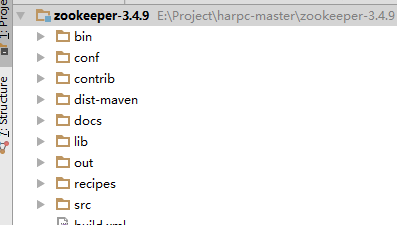
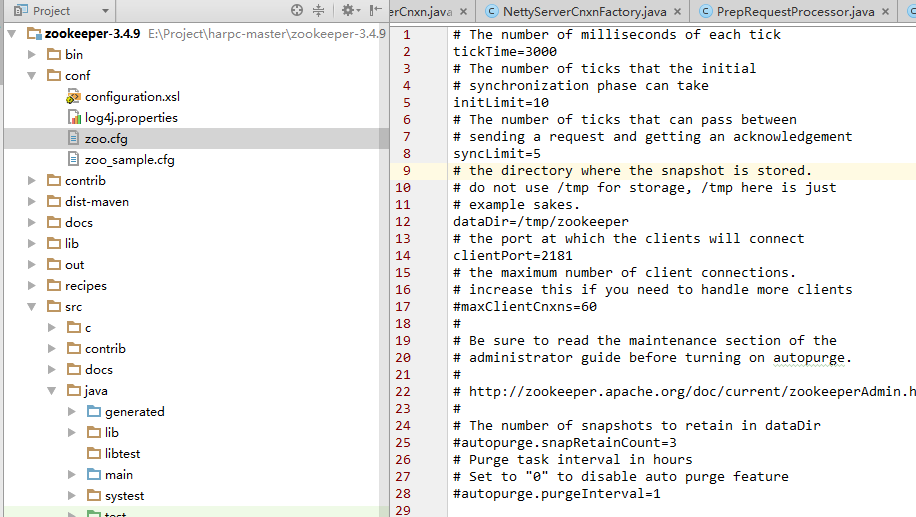
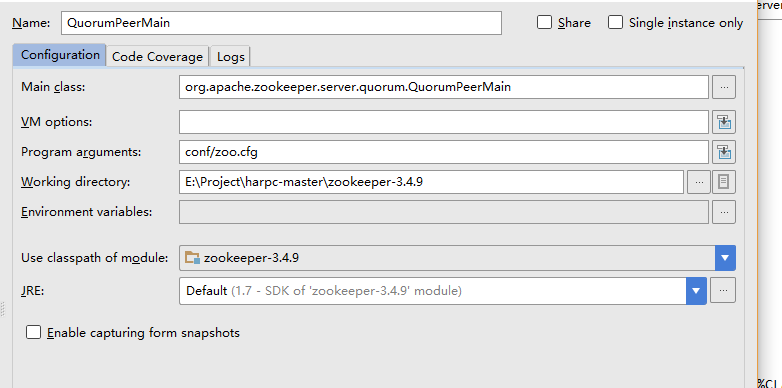

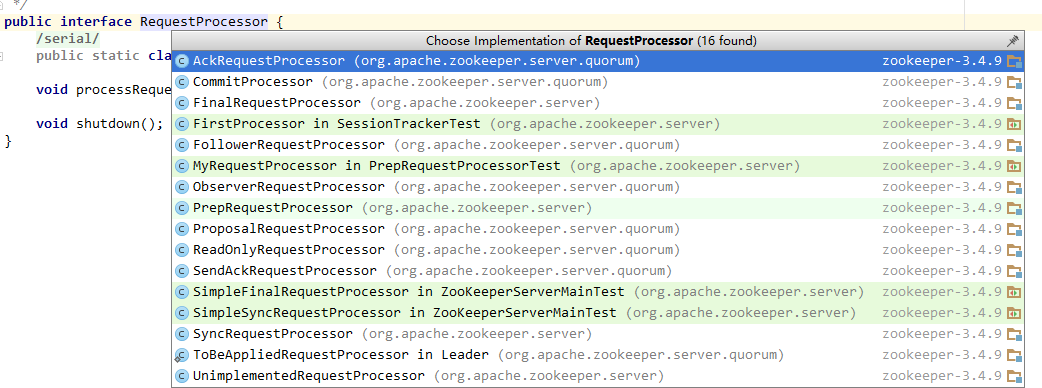
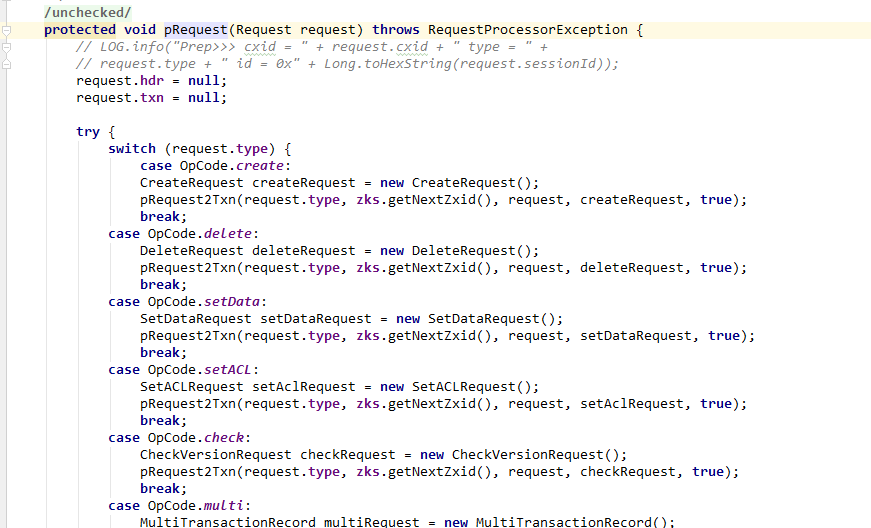




【推荐】国内首个AI IDE,深度理解中文开发场景,立即下载体验Trae
【推荐】编程新体验,更懂你的AI,立即体验豆包MarsCode编程助手
【推荐】抖音旗下AI助手豆包,你的智能百科全书,全免费不限次数
【推荐】轻量又高性能的 SSH 工具 IShell:AI 加持,快人一步
· 记一次.NET内存居高不下排查解决与启示
· 探究高空视频全景AR技术的实现原理
· 理解Rust引用及其生命周期标识(上)
· 浏览器原生「磁吸」效果!Anchor Positioning 锚点定位神器解析
· 没有源码,如何修改代码逻辑?
· 全程不用写代码,我用AI程序员写了一个飞机大战
· DeepSeek 开源周回顾「GitHub 热点速览」
· MongoDB 8.0这个新功能碉堡了,比商业数据库还牛
· 记一次.NET内存居高不下排查解决与启示
· 白话解读 Dapr 1.15:你的「微服务管家」又秀新绝活了